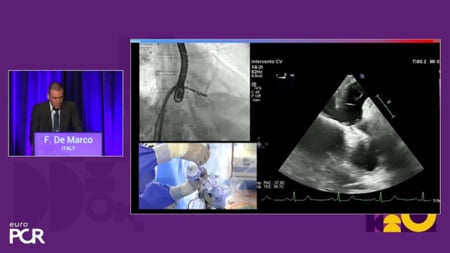Transcatheter edge-to-edge repair for treatment of tricuspid regurgitation
Selected in JACC by S. Brugaletta
The purpose of this report was to study the 1-year outcomes with the TriClip transcatheter tricuspid valve repair system, including repair durability, clinical benefit and safety.
References
Authors
Philipp Lurz, Ralph Stephan von Bardeleben, Marcel Weber, Marta Sitges, Paul Sorajja, Jörg Hausleiter, Paolo Denti, Jean-Noël Trochu, Michael Nabauer, Gilbert H.L. Tang, Patric Biaggi, Shih-Wa Ying, Phillip M. Trusty, Abdellaziz Dahou, Rebecca T. Hahn, Georg Nickenig, and on behalf of the TRILUMINATE Investigators
Reference
J Am Coll Cardiol. 2021 Jan, 77 (3) 229–239
Published
January 2021
Link
Read the abstractReviewer
Latest contributions
PARTNER 3: transcatheter or surgical aortic-valve replacement in low-risk patients at 7 years 1-year SELUTION DeNovo results: drug-eluting balloon strategy vs. systematic drug-eluting stent in de novo coronary disease Optical coherence tomography- vs angiography-guided coronary stent implantation in calcified lesions: the ILUMIEN IV trialMy Comment
Why this study? – the rationale/objective
Tricuspid regurgitation (TR) is a frequent disease with a progressive increase in mortality as disease severity increases. Transcatheter therapies for treatment of TR may offer a safe and effective alternative to surgery in this high-risk population.
The purpose of this report was to study the 1-year outcomes with the TriClip transcatheter tricuspid valve repair system, including repair durability, clinical benefit and safety.
How was it executed? – the methodology
The TRILUMINATE trial (n = 85) is an international, prospective, single-arm, multicenter study investigating safety and performance of the TriClip Tricuspid Valve Repair System in patients with moderate or greater TR. Echocardiographic assessment was performed by a core laboratory.
What is the main result?
At 1 year, TR was reduced to moderate or less in 71% of subjects compared with 8% at baseline (p < 0.0001). Patients experienced significant clinical improvements in New York Heart Association (NYHA) functional class I/II (31% to 83%, p < 0.0001), 6-minute walk test (272.3 15.6 to 303.2 15.6 meters, p 1⁄4 0.0023) and Kansas City Cardiomyopathy Questionnaire (KCCQ) score (improvement of 20 2.61 points, p < 0.0001). Significant reverse right ventricular remodelling was observed in terms of size and function. The overall major adverse event rate and all-cause mortality were both 7.1% at 1 year.
Critical reading and the relevance for clinical practice
The TRILUMINATE study is a registry of feasibility and efficacy of the tricuclip for the treatment of tricuspid regurgitation. The authors should be congratulated for performing this industry-funded study, which indeed succeeds to show that tricuclip procedure may be performed in a safe and effective way, aiming to reduce not only the grade of tricuspid regurgitation but also to improving functional class of such patients at 1-year follow-up.
However, there are some methodological points which should be taken into account. First of all, it should be considered that 85 patients have been included in 21 sites, which means around 4 patients per site in a time period of almost 2 years. This should make us think about how frequent is this disease or to how many patients the tricuclip system may be used. Inclusion clinical and anatomical criteria are of utmost importance to decide which is the patient who may benefit the most from this device.
In mitraclip, it has been well said that patient selection is the first and the most important step to make a successful procedure, as the two main trials available gave different results. Unfortunately, in tricuclip, this process is still under construction and not well explained. Other devices are and will be available soon and patient selection would play a key role in this field.
The second point is about the additional value of this 1-year follow-up as compared to the 6-month follow-up already published in a previous paper. The authors herein compare 30 days with 1-year, but it is unknown whether there is an additional advantage of this device between 6 and 12 months. Given the use of a generalized linear model for repeated measurements, one would expect the authors to use all the available time points of repeated observations (baseline, 30 days, 6 months and 12 months), without eliminating the 6-month data in this report. Lack of these data does not clarify if the present paper has some value to what has been published already and if our hypothetical patient has reached already at 6 months a recovery without any further improvement thereafter.
Do you have access in your centre to devices to treat tricuspid regurgitation? How do you select patients?





No comments yet!